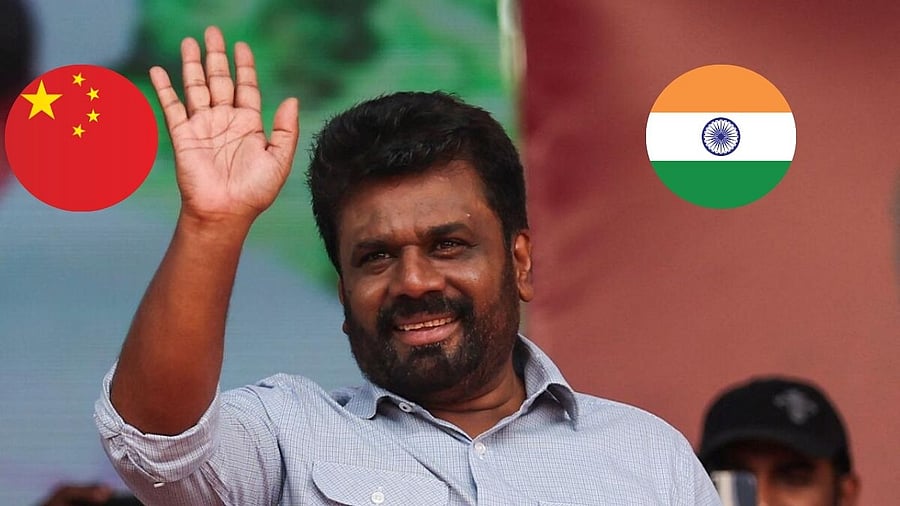
Anura Kumara Dissanayake seen here with inset images of Chinese and Indian national flags
Credit: Reuters and iStock Photos
Sri Lankan President Anura Kumara Dissanayake’s choice of making his first State visit to India in December was significant because of the perception that his party, the Janatha Vimukthi Peramuna, is a Left-leaning pro-China party.
A month later, in January, Dissanayake made a State visit to China at the invitation of President Xi Jinping. Comparing the joint statements from these two visits reveals the similarities and differences in the strategies pursued by India and China, as well as the nuances in Sri Lanka’s response.
The new Sri Lankan leadership has taken a tone of restraint on engagements with China when compared to the previous dispensations. This can be seen as an outcome of political confidence domestically, the economic crisis, and the subsequent difficulties in finalising the debt restructuring deal, as well as the growing Indian sensitivity to Sri Lanka’s closeness with China.
In case of both India and China, co-operation with Sri Lanka covers not only traditional arenas like trade, but also connectivity, training and capacity building, education, tourism, agriculture, healthcare, and technology exchange. Along with debt restructuring, where Sri Lanka recognised the positive role that India and China played, disaster resilience and climate change are other overlapping areas of co-operation. The salience of climate change in the joint statement with China has increased from a passing mention in the previous statements to a more detailed paragraph about sharing advanced technology and personnel training and joint achievement of the UN 2030 SDGs.
India and China have also proposed co-operation in the field of governance: India via Digital Public Infrastructure and establishing equivalent systems to Aadhaar, Gati Shakti, DigiLocker, and UPI payments, and China via law enforcement capacity-building and poverty alleviation. In the past, the Sri Lankan side called Chinese style modernisation a ‘choice and practical plan for developing countries’. In the current statement, it merely applauded the achievements of this developmental model in making China a strong nation and the opportunities that reform in China would bring to economic development in Sri Lanka. This is crucial as research has shown that Chinese-funded infrastructure projects in the last decade have influenced governance frameworks and legal mechanisms in Sri Lanka.
There are notable divergences too. In case of China, ‘core interests’ take precedence above everything else. In continuation with the statements from 2023 and 2024, China put a strong emphasis on ‘One China’ and opposition to ‘Taiwan Independence’. There was an additional reference to the UNGA Resolution 2758, that made PRC the legitimate representative of China in the UN, and support for China on issues related to Tibet and Xinjiang. However, there was no mention of defence co-operation. This joint statement, instead, alluded to domestic law enforcement and public security. This is in contrast to the 2016 statement which called for close ties in defence and security co-operation between the two countries.
This is also in contrast to the wide array of planned strategic and defence co-operation between India and Sri Lanka ranging from maritime surveillance, bilateral exercises, to provision of defence platforms and assets, and tailored training programmes. India also expressed support for the Colombo Security Conclave for regional maritime security. Sri Lanka reiterated the position of ‘not permitting its territory to be used in ways that are inimical to security of India’, responding to India’s concerns about Chinese maritime activities. However, while engaging positively with India, in the joint statement with China, Sri Lanka reaffirmed its ‘independent, non-aligned foreign policy’.
A major difference between the two joint statements can be seen in the modes of implementation. Chinese statements emphasise making Sri Lanka a part of China-led global initiatives such as the ‘BRI Green Development Coalition’ and ‘Asian Alliance for Cultural Heritage Protection.’ Further, there is greater prominence than in previous statements in 2024, 2023, and 2016, on the leadership of Xi and his ‘major ideas and proposals’ — the Global Development Initiative, the Global Security Initiative, and the Global Civilisational Initiative. In contrast, India’s mode of operation seems more bilateral and focused on individual projects. India also expressed support for Sri Lanka’s presence in the existing regional frameworks like the IORA and BIMSTEC.
While there is continuity with the past governments in Sri Lanka, in areas such as trade, economy, and infrastructure development, Dissanayake’s visit highlights subtle differences in the narrative indicating the rapidly changing nature of engagement with the two dominant powers in the region. For Indian policymakers, this means paying closer attention to China’s new broader regional and global initiatives, that underline its ambitions to position smaller states within its BRI framework. Emphasis on timely delivery of ongoing projects and boosting India’s status as the ‘first responder’ in times of crisis are steps in the right direction.
(Shruti Jargad is research analyst, Centre for Social and Economic Progress, New Delhi. X: @SJargad.)
Disclaimer: The views expressed above are the author's own. They do not necessarily reflect the views of DH.